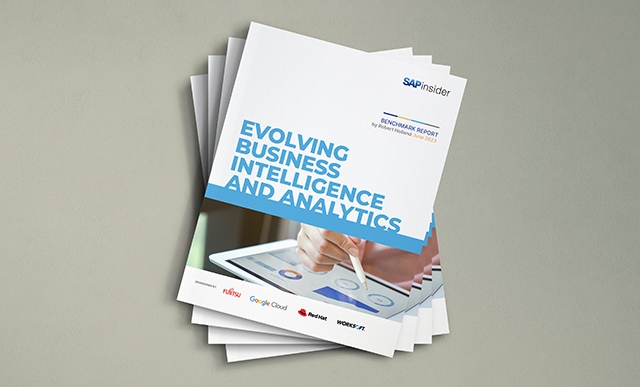BI 2017, HANA 2017, and Basis & SAP Administration 2017: Keynote Recap
To kick off BI 2017, HANA 2017, and Basis & SAP Administration 2017, SAP’s Mike Flannagan delivered an insightful keynote talk, followed by a deep dive into some emerging technologies with Chris Dinkel and Jag Bandla of Deloitte Consulting LLP.
In his keynote, Mike Flannagan, Senior Vice President of Analytics, spoke on why he chose to recently join SAP and what aspects of SAP’s portfolio he’s most excited about. For Flannagan, analytics is about more than being able to leverage data for better business decisions. SAP certainly does that and does it well, but what really differentiates the company’s analytics portfolio, in Flannagan’s opinion, is the way SAP helps support the implementation of those decisions. After all, anyone can make a decision. Following through on it is another matter, and SAP aims to help with that follow through.
The company’s solution portfolio does this in a number of ways. In his talk, Flannagan spoke in particular about SAP Digital Boardroom and SAP BusinessObjects Cloud. Both of these solutions help further the success of business decisions by bringing business intelligence (BI), business planning, and predictive analytics together in one place. They also connect with all other aspects of the organization, bringing in data from SAP SuccessFactors, SAP Hybris, SAP Ariba, and other cloud solutions to make analytics a seamless part of the workflow. In particular, a video demonstration of SAP Digital Boardroom showed how the solution can call up real-time analytics to answer ad-hoc questions, perform what-if scenarios, and display constant tracking of KPIs, thereby giving you immediate insights into whether your business decisions are being implemented and if the goals of those decisions are being met.
Explore related questions
3 Priorities for the Future
Going forward, Flannagan spoke of three priorities for the future of SAP’s analytics portfolio:
- The first is to ensure that organizations that have already made large investments into legacy analytics systems from SAP can continue to see returns on those investments. This means delivering innovations and support to those on-premise systems.
- The second priority is to ensure that SAP is leading with the cloud. The cloud enables both a greater speed for innovation and greater opportunities for self-service analytics. SAP hopes to be a leader in that space to better support its customers.
- The final priority for SAP’s analytics portfolio is to adopt a mobile-first strategy. Today’s workforce spends less and less time inside an office and at their desk. If analytics capabilities are not mobile, they’re not accessible.
Together, these three priorities suggest a greater focus on hybrid IT. Analytics solutions based on premise need to be able to work seamlessly with mobile and cloud solutions. Flannagan stated that perfecting the intersection of on-premise, cloud, and mobile analytics solutions in order to support a hybrid structure is an important goal for SAP going forward.
In fact, the organizational structure of IT was a running theme throughout this keynote address. Flannagan frequently returned to the concept of “bimodal IT” – the idea that IT today is pulled in two directions. On the one hand, IT must keep the business running as usual, keeping the lights on and ensuring that there are no major disruptions. On the other, IT must implement innovative, differentiating technologies if a company is going to stay competitive. Finding the balance between the two is one of the greatest challenges that organizations will face. However, an innovative analytics solution that simplifies business intelligence, planning, and predictive analytics is a key starting point for mastering bimodal IT.
The Changing Nature of IT
Flannagan’s overview was followed by a talk from Chris Dinkel, SAP Analytics Leader, and Jag Bandla, SAP S/4HANA & Analytics Leader, at Deloitte Consulting LLP, that looked at Deloitte’s eight technology trends of 2017 and what these trends mean for the business. Topics covered ran the gamut from machine intelligence to cloud architecture to the blockchain. But there were a few key themes underlying all eight of these trends.
First and foremost of these themes is the changing nature of IT. Like Flannagan, Dinkel and Bandla expounded on the importance of bimodal IT by discussing the concept of “IT unbounded.” Simply put, this trend refers to the need for IT to move beyond basic systems maintenance and become a competitive differentiator in the business. They also discussed the increasing adoption of new forms of IT architecture, such as cloud technologies, calling this trend “inevitable architecture.” The inevitability of newer, simpler forms of IT architecture coming from the drive to be increasingly like a start-up – flexible, agile, and innovative – gives this trend its name. According to Bandla, eventually moving to SAP HANA is a necessity for organizations, and businesses are running out of excuses to not adopt the cloud. Cloud technologies are becoming so prevalent that we are moving toward an “everything-as-a-service” world. The offerings of cloud applications will only become more diverse and will grow to the point where nearly anything can be hosted in the cloud.
This increasing cloud adoption will lead to more hybrid IT landscapes in upcoming years, which means that connectivity needs to be a greater focus. Moving data from one app to another already wastes a great deal of time in organizations. To simplify that process, businesses must move toward an API economy, leveraging APIs to create better connectivity throughout all parts of the business and beyond.
This focus on connectivity echoes Flannagan’s emphasis on providing analytics solutions that integrate seamlessly with workflows. And indeed, powerful was certainly in the spotlight during Dinkel and Bandla’s talk. Dinkel discussed the growing trend of machine intelligence, exploring how cognitive analytics is moving beyond predictive and will soon become prescriptive – able to determine the best course of action instead of simply predicting what results each course of action will yield. Dinkel also introduced the idea of “dark analytics,” or the ability to use analytics to derive insights from unstructured data, including audio, visual, and even dark web data.
Additional trends that are not yet common in enterprises include mixed reality (demonstrated via a video that showcased Deloitte’s Lens product) and blockchain technology, which is poised to disrupt the financial industry.
Conclusion
The keynote address of this year’s BI, HANA, and Basis & SAP Administration events covered a lot of ground and examined a wide range of fascinating technology trends. Throughout all the topics covered, however, one thing is apparent: Enterprise technology is heading in exciting new directions. Organizations have a world of opportunities ahead of them. By mastering the complexities of bimodal IT and embracing new innovations in the analytics space, businesses can keep abreast with these changes and embrace innovation.






